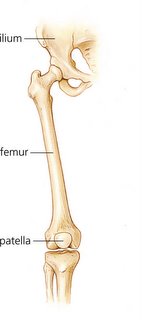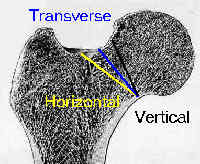
Normal hip

Types of Neck of Femur fracture
1) Cross-check x-rays with markings made with a marker on patient's thigh. Ensure that the correct thigh has been identified for the operation.
2) Incision made at the hip, making cuts through the skin, the fat, then the muscles, to finally reach the femur (thigh bone) that was broken.
3) Twist and manipulate thigh and out pops the fractured femur!
4) Saw off the head of the femur and put it aside. Drill a hole down the center of the length of the femur and insert an artificial new “head” (ball-bearing looking thing) to replace the fractured one.
5) Now “polish” the other end of the joint – the hip end, using an equipment (a reamer) to “polish” off bits of the remaining cartilage so that all cartilage is removed and the joint is “smooth” and “clean”.
6) Insert artificial “plastic cartilage” to the hip end of the joint and secure in place with cement.
7) Wait... for... cement... to... dry...
8) Pop new "head of femur" back into hip joint.
9) Manipulate leg - flex, extend etc etc at hip joint to ensure that hip joint articulates well and range of motion is not compromised.
10) Once satisfied, sew up incision and apply wound dressing.
------------------------------
10-steps to a Total Hip Replacement - Not!
That obviously excludes all the
a) pre-op work: x-rays, preparing the patient for surgery, anesthesia, ensuring heart rate and blood pressure are stable and satisfactory for surgery, preparing all the equipment required...
b) other work during the op: draining blood, burning shut major blood vessals to stop bleeding (crudely put; otherwise known as electrocauterization), checking blood loss...
------------------------------
Standing on the stool next to the surgeons
meant I had a bird's eye view.
And some hands on experience!
One of the surgeons handed me the excess cement to "play" with.
I held it and felt it give off heat as it hardened.
Yes, the excess cement was bloody.
Yes, I was brave.
And YES, I wore gloves!
Overall, the operation wasn't overly bloody - 1.2l blood loss?
but it was BRUTAL!
Twisting, sawing, pounding, pushing, shoving, pulling, drilling, hammering...
And these were 2 adult men doing the work!
Hard work I say...
I observed a Spinal Operation (slightly less brutal, much more bloody, not any less fascinating although everything was so small so I couldn't see a lot of things - despite being next to the surgeon. And on the stool again) on a seperate occasion and the surgeon doing that was quite a large man - I think I glimpsed an "XXL" on his gown, but I can't be sure.
He had inserted 6 metal rods into the patient's back (young man, motorbike accident, fractured spine) and he was now trying to cut off the excess length of the metal rods. Just that part of the operation took a good 15mins and by the end of it, he was perspiring. Lovely man he was, though. Despite being busy (with the operation, obviously) and perspiring from the effort, he turned and said to me: "This is why orthopedic surgeons are more my size and less your size." I was so completely charmed by his sense of humour that I almost fell off the stool face-down onto the patient's bloody back.
The point of me emphasizing the brutality of these operations is not to emphasize the dangers, the grossness or the scariness of these operations. Rather, it's to highlight the amazing strength of our bones, muscle, and ligaments. Our bodies are truly remarkable!
This site provides an excellent video (compared to my extremely crude description) of a Total Hip Replacement. It explains the anatomy of the hip in clear, simple terms (no previous knowledge required), explains the Total Hip Replacement procedure step by step with beautiful graphics and even has an interactive component where you can move up/down or rotate the diagram to see it from all angles. My favourite bit is the post-op precautions: how not to dislocate your new hip (incidentally, that's part of my job -educating/emphasising/nagging patients on hip precautions and providing equipment to prevent dislocations). The video is a blood-less version, suitable for all ages!
1 comment:
I am pretty sure it is not suitable for all ages (for example, not suitable for me). Just reading what you described is gross enough....I am so glad I am not an occupational therapy....
Eeewwww....Sorry, no offense to your job =p
Are you going back to s'pore for holidays?
Post a Comment